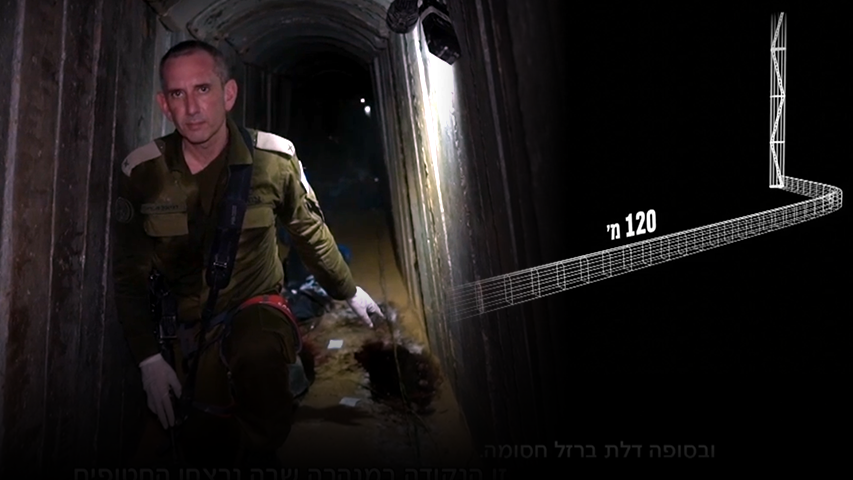Getting your Trinity Audio player ready...
The IDF spokesman on Tuesday evening screened the video of the tunnel under Rafah in Gaza where hostages Hersh Goldberg-Polin, Eden Yerushalmi, Ori Danino, Almog Sarusi, Carmel Gat and Alex Lobanov were held and executed at the end of last month. The army first presented the video to the families and they agreed to show it to the public as well. In the video, one sees IDF spokesman Daniel Hagari going down into the low tunnel, and not being able to stand upright inside it, and describing what he sees there and how the hostages were held in it.
The bodies of the hostages were found in several separate places in the tunnel, which was about 20 meters deep and spread over about 120 meters. There were no toilets in the tunnel and the forces discovered bottles of urine and a rudimentary septic tank there. "Let the whole world see the evil and understand the cruelty," Hagari said.
Watch the video:
The tunnel where the six hostages were held captive and murdered
(Video: IDF Spokesperson's Unit)
The murdered hostages survived almost 11 months in captivity and were held in a tunnel in inhumane conditions , while starving and living without basic hygiene. The hostages had very little food in captivity, and they lost significant weight. Eden Yerushalmi's body was found weighing only 36 kg (79 pounds).
At a press conference Tuesday evening, Hagari noted that the video was also distributed in English, "so that the whole world can see the evil of Hamas and know how it treats hostages with cruelty." Hagari noted that additional hostages are believed to be held in these harsh conditions. Hagari shows in the tunnel blood stains at the point where he says the hostages were murdered. "It's a transit tunnel, you can't stand here," Hagari described while bending over, emphasizing that the humidity there also is difficult. Hagari also displayed bottles filled with urine that littered the tunnel.
6 View gallery
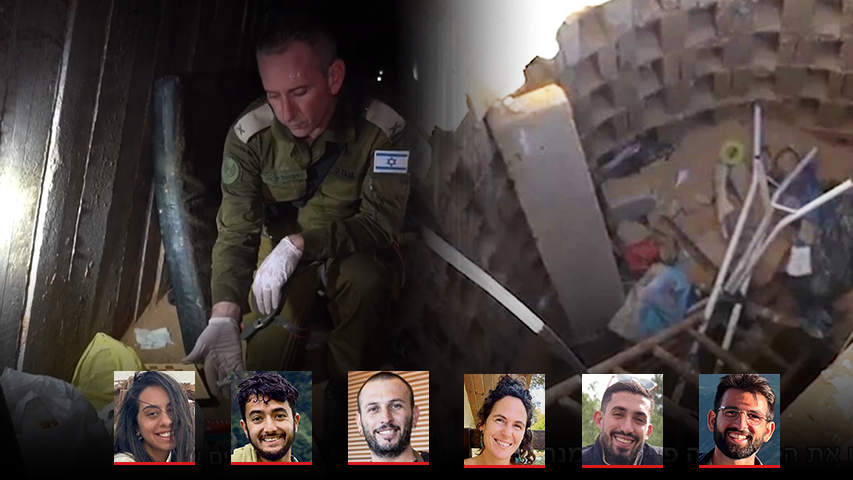

IDF spokesman Daniel Hagari shows conditions inside the tunnel where the six hostages were held and executed
(Photo: IDF Spokesperson's Unit)
In response to Ynet's question about whether the IDF has a strategy to keep the hostages who remain in captivity alive, Hagari said that the IDF is "discussing with the political echelon how to keep them alive." When asked whether Hamas will send Yahya Sinwar through the Philadelphi Corridor to Egypt and from there to Iran, Hagari replied that he did not have "information" about such a plan.
The video was shown to the ministers at the meeting of the political-security cabinet on Monday, and they expressed shock at it, calling the Hamas captors "monsters," "animals," and "this just shows who we're dealing with." Sources present at the meeting described it as "extremely tough to watch." The atmosphere in the room was tense, and the video underscored both the brutality of Hamas and the dire situation of the remaining hostages.
In response to the screening of the video on Israeli television, hundreds of protesters began rallying in Tel Aviv, calling for a deal that would release the remaining hostages held in Hamas captivity.
In the video, which was photographed by the IDF forces and presented to the ministers under the guidance of Defense Minister Yoav Gallant, one can see the narrow tunnel where the hotages were held while starving and living in the absence of basic hygiene. Among other things, the video shows blood stains, discarded clothes and bottles of urine.
The six hostages were murdered in a tunnel in the Tel al-Sultan neighborhood in West Rafah by their captors from Hamas about 10 days ago, after they apparently feared a possible rescue operation by the IDF that was operating in the area. The tunnel where the hostages were kept came out of a house , and the shaft that led to it was under the floor of a child's room.
6 View gallery
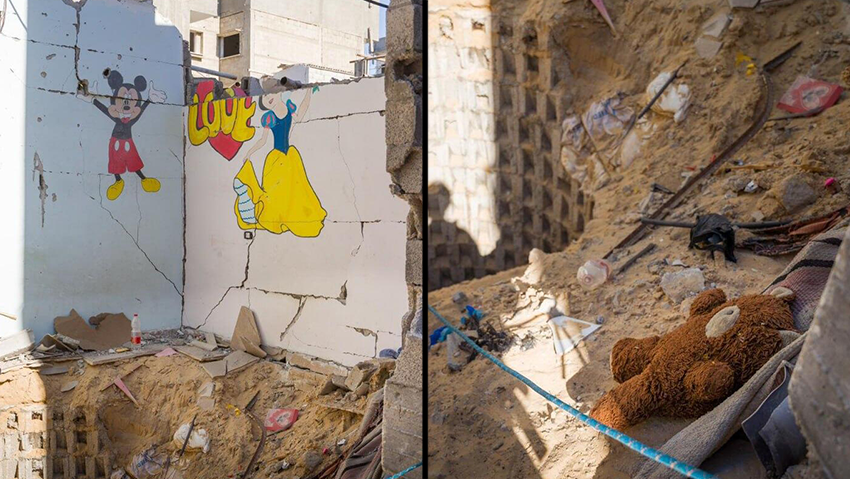

The entrance to the tunnel was found inside a children's room in West Rafah in Gaza
(Photos: IDF spokesperson's unit, AP Photo/Susan Walsh)
The forces had to break the floor to reach the shaft and from there trace the route of the tunnel at a depth of about 20 meters, when from the analysis of the tunnel it becomes clear that it is a tunnel for the passage between underground fighting sectors of Hamas. The findings also show that apparently two terrorists shot dead the six hostages between Thursday (August 29) and Friday, and then left through the front door and locked it behind them.
The same iron top door, which the fighters uprooted two days later when they arrived, was locked on the hostages during their captivity in the tunnel. According to the dry food, the little water that was in the tunnel, the bottles of urine and the septic tank that was used by the hostages as a toilet, the army estimates that the hostages were held there for several weeks at least, and before that they were moved from place to place, possibly from the Khan Younis area.
6 View gallery
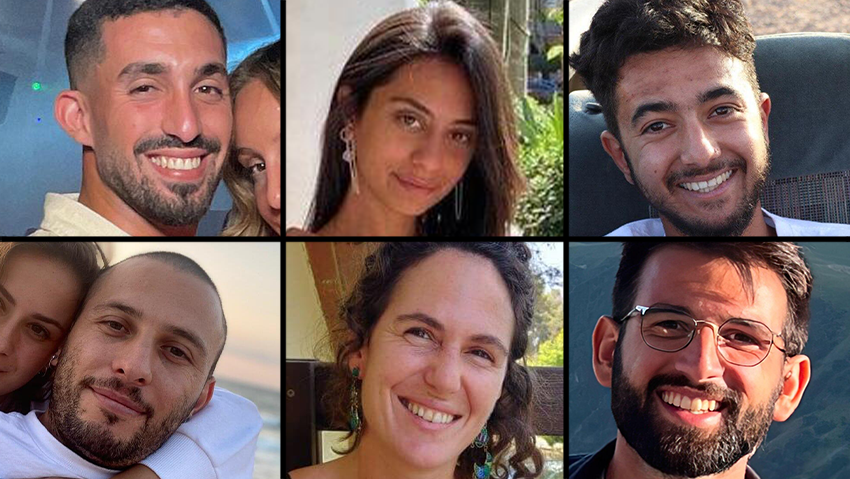

IDF released a video of the tunnel where the 6 executed hostages were held
(Photo: Courtesy of famiies)
The findings also show that the information given by hostage Farhan Qadi, who was found alive a few days earlier in a nearby tunnel, did not include information about the six murdered hostages. His investigation is still ongoing, and the army emphasized that there was no concrete intelligence regarding the location of the six hostages in the tunnel. The IDF said that the soldiers who operated in that tunnel complex took extra caution and even more so after a special situation assessment was conducted after Farhan was found, at the end of which IDF Chief of Staff, Major General Herzi Halevi directed the forces to act to locate terrorists alive in this area in order to extract intelligence from them in their investigation regarding the locations of hostages.
Many traces of blood were found in the tunnel, and the IDF is checking whether some of them, along with other DNA findings, belong to two terrorists who were killed in the same area in two separate encounters a few days later. The IDF also stated that the fighting in the Tel al-Sultan battalion of Hamas continues and that the commander of the Hamas battalion in the neighborhood was eliminated in the last two weeks by the IDF.
6 View gallery
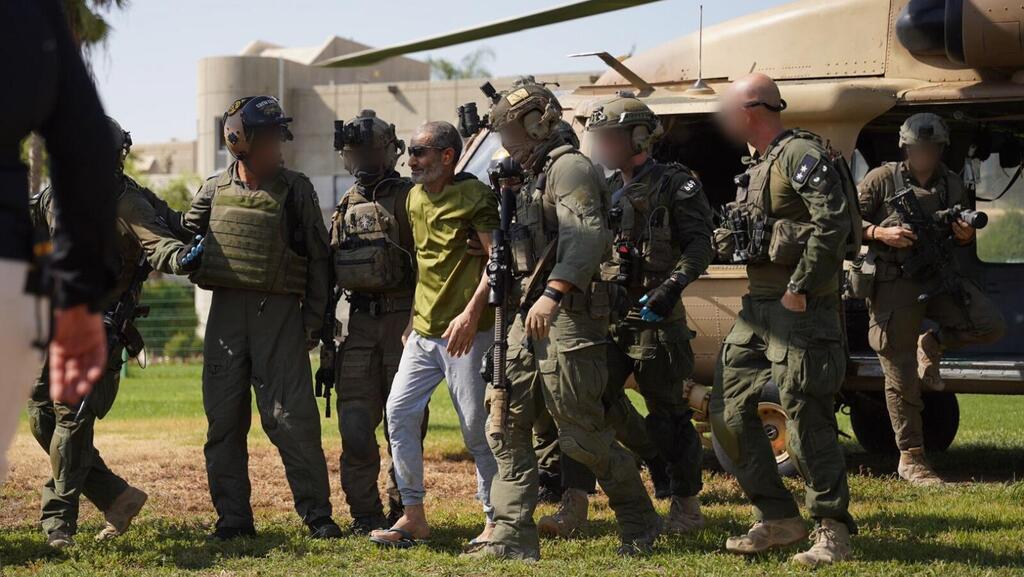

Farkhan Qadi leaves the helicopter that spirited him out of Gaza at Sheba Medical Center
(Photo: IDF Spokesperson's Unit)
The tunnel in which Qadi was held was about 700 meters away from the tunnel of the six executed hostages, but between the two tunnels there was an engineering barrier; it is not yet clear whether it was caused by IDF activity in the area or a deliberate collapse by Hamas operatives.
The security officials said at the cabinet meeting where the video was screened that other hostages are being held captive under similar conditions. There are 101 hostages currently being held captive, with many of them believed to be dead. Hamas admitted that they had executed the six hostages, and the terrorist organization said that they had issued "new instructions" to the terrorists holding the hostages after the rescue operation from Nuseirat ("Operation Arnon") in June.
'I asked Hagari if it was hot there. He said "a catastrophe"'
Shirit Yerushalmi, mother of murdered hostage Eden, said that the IDF spokesman showed them the video on Saturday. "He couldn't say how long Eden was there, but according to what they found it is estimated that it was for weeks. We were shocked. The tunnel is very narrow and stifling, there was no fan or lighting. There was a battery and headlamps, a lot of drinking bottles, and energy bars. That's all in terms of food."
"There were mattresses like the army's, the small dark ones," she said. "If they don't lie down, they have to be placed against the wall so that they can pass through. It's not even a tunnel, it's a passage through the tunnel. The width is the width of a mattress and the height is low. (IDF spokesman Daniel) Hagari said he couldn't stand upright in it."
"There was no toilet or bath," the mother added about the conditions in which her daughter was kept. "There was a bucket there, full bottles of urine. The conditions were terrible. There was hardly any air. I think what held them together, especially Eden, was their togetherness. They were six heroic hostages and each of them is a whole world to their family. I believe they strengthened one another. Knowing that Eden was with another girl also encouraged me, that she was not a woman alone; It encouraged us even more because we knew the people from the stories and the articles."
"Watching the video I felt shock," she added. "My heart broke, it hurt. The tunnel is so narrow, there is no air, it's so hot. I asked the IDF spokesman what the weather was like inside if it was hot outside, and he said it was a catastrophe. It was very difficult for us as a family to understand where she was. We also don't know where she was before, no one can tell us."
6 View gallery
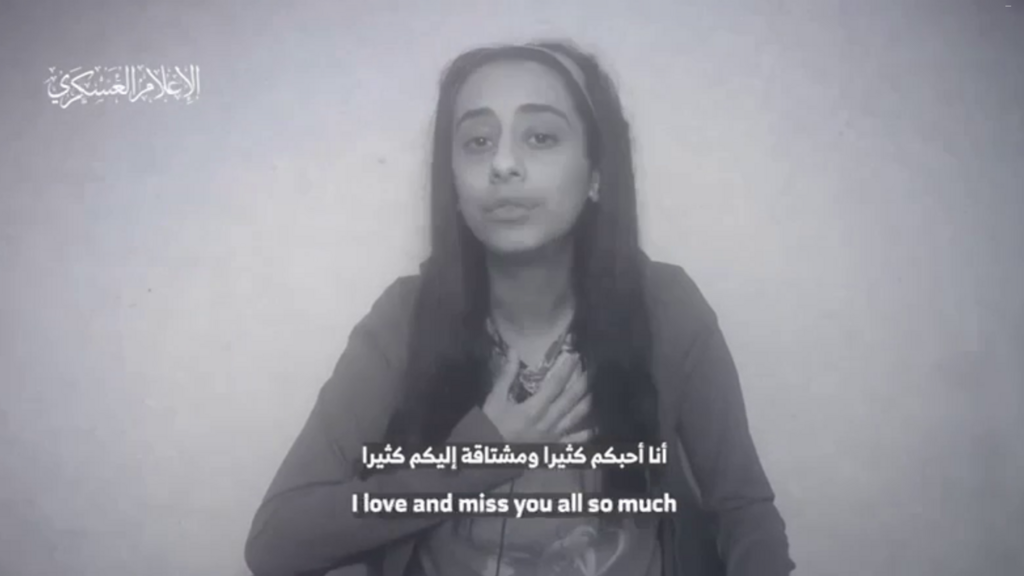

Video taken by Hamas of Eden Yerushalmi from captivity in the Gaza Strip
(באדיבות מטה משפחות החטופים)
"They survived 11 months, and to think that they were so close to getting out and then to be murdered, she continued. "At first it was puzzling to me that Farhan was alone, I asked if he was with them but I realized that he was being interrogated and he wasn't with them. Maybe they decided not to murder Him because he is Muslim, that's the luck he had. I wish my daughter and the other hostages had that luck."
"The president of the country, hostage envoy Gal Hirsch, and also the prime minister and his wife arrived," the mother added. "We allowed everyone who wanted to console to come. The prime minister was very sensitive to the issue, he expressed deep sorrow, we heard him and he heard us. We were not looking to make accusations, from the beginning we were not looking for it. We do want answers about the failure of October 7, about the huge disaster, but I allowed the prime minister to come. I just mentioned to him that I hope that other families will not experience this great loss and sorrow and that I hope they do everything."
The murder of the six hostages in captivity provoked tremendous outrage and a wave of demonstrations in Israel, claiming that the manner in which Prime Minister Benjamin Netanyahu conducted the negotiations for the deal caused the agreement to be delayed - and thus prevented the rescue of at least some of the hostages who were murdered and were supposed to be released in the first round of the new deal for humanitarian reasons. Relatives of the hostages also are expressing grave concern that the military pressure exerted by the IDF on Hamas will result in the death of their loved ones.
At a Knesset committee meeting on Monday, Esther Buchshtab, whose son Yagev was murdered in captivity by Hamas and whose body was recovered from Khan Younis three weeks ago, also confirmed her son had been executed. "My son was kidnapped alive. He was supposed to return alive, but he came back dead – murdered," she said.






